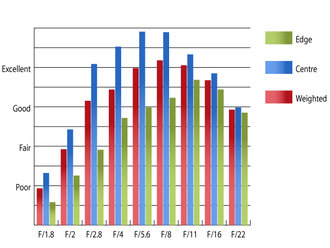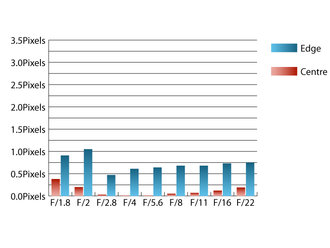Canon EF 28mm f/1.8 USM Lens Review
Canon EF 28mm f/1.8 USM Performance
As far as resolution is concerned, this lens disappoints, especially at apertures faster than f/2.8. At f/1.8 clarity in the centre of the image is fairly poor. Images taken at this setting has a hazy appearance, thanks to uncorrected spherical aberrations robbing images of any contrast or sharpness. The less said about the quality towards the edges of the frame at f/1.8 the better.Stopping down does improve quality across the frame as the effect of spherical aberrations on the image diminish. A big jump in sharpness level in the centre of the frame can be seen with the lens stopped down to f/2.8, but the clarity towards the edges of the frame doesn't reach good levels until the lens is stopped down beyond f/8.
Peak sharpness across the frame is achieved at f/11, where clarity in the centre is excellent, and very good towards the edges of the frame.
 Resolution at 28mm | How to read our charts The blue column represents readings from the centre of the picture frame at the various apertures and the green is from the edges. Averaging them out gives the red weighted column. |
Chromatic aberrations can be an issue at wide apertures also. At f/2, fringing exceeds one pixel width, which may cause issues with images that have high contrast edges towards the periphery.
Falloff of illumination towards the corners of the frame is quite pronounced, as you might expect from a wide aperture lens like this. At f/1.8 the corners are 2.12 stops darker than the image centre and visually uniform illumination is achieved when stopped down to f/5.6 or beyond.
 Chromatic aberration at 28mm | How to read our chartsChromatic aberration is the lens' inability to focus on the sensor or film all colours of visible light at the same point. Severe chromatic aberration gives a noticeable fringing or a halo effect around sharp edges within the picture. It can be cured in software.Apochromatic lenses have special lens elements (aspheric, extra-low dispersion etc) to minimize the problem, hence they usually cost more. For this review, the lens was tested on a Canon EOS 1Ds Mark III using Imatest. |
Only a mild level of 1.49% barrel distortion is present and the distortion pattern is uniform across the frame, which should make it relatively straightforward to correct in image editing software afterwards. Although level of distortion present is only mild, it's still probably slightly more than you might expect from a prime lens like this.
No lens hood is supplied as standard by Canon with the 28mm f/1.8. Unfortunately flare and loss of contrast can be be issues when shooting into the light, or with a light source, such as the sun in the frame.
Add your message
Login required
Please login here or if you've not registered, you can register here. Registering is safe, quick and free.
Please login here or if you've not registered, you can register here. Registering is safe, quick and free.
photodo Stats
1102 lenses
428 MTF tests
74 in-depth photodo reviews
100+ users join each day
Help the lens community by reviewing or rating a lens today via our lens search
428 MTF tests
74 in-depth photodo reviews
100+ users join each day
Help the lens community by reviewing or rating a lens today via our lens search
Latest Lens Reviews
- Chinon 28mm f/2.8 Vintage Lens Review
- Canon EF 70-200mm f/4L IS II USM Lens Review
- Samyang AF 85mm f/1.4 EF Review
- Sigma 70mm f/2.8 DG Macro Art Review
- Samyang AF 24mm f/2.8 FE Review
- Meike 50mm f/1.7 Review
- Tamron 70-210mm f/4 Di VC USD Review
- Lensbaby Burnside 35mm f/2.8 Review
- Asahi Super Takumar 50mm f/1.4 Review
- Asahi Super-Multi-Coated Takumar 135mm f/3.5 Review
